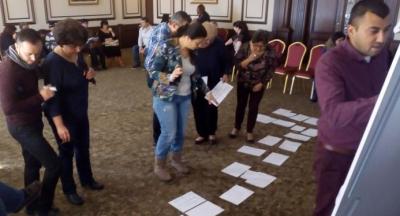Slivo Pole
*Disclaimer: The information and views set out in this page do not necessarily reflect the official opinion of the Council of Europe and/or the European Commission. Neither the Council of Europe, the European Commission nor any person acting on their behalf may be held responsible for the use which may be made of the information contained therein.
Slivo pole Municipality is located in Northern Bulgaria and is one of the municipalities of Rouse province. The municipality has 11 settlements with a total permanent population of 9.958 residents. Roma population in the municipality is about 11 % (1.102), from which 26% (286) live in the municipal center and the others 74% in the villages.
The highest number of Roma population is in Malko Vranovo village - 933 inhabitants (50%). Another village with Roma concentration is Kosharna – 574 inhabitants (32%). The Roma people in the municipality of Slivo pole not live in isolation from other ethnic groups. Overall, the infrastructures in the Roma neighborhoods is satisfactory, there are electricity and water supply networks, but the sewerage system is inexistent. In the component villages, the road infrastructure is poor or missing, with individual properties lacking electricity and water.
In Slivo pole, Roma live mainly in the southern part of the city (Slivitsa neighborhood), but the territory is not established as a ghetto. The main part of Roma lives in houses with courtyards, the lands are private municipal property allocated for residential building. Parts of the dwellings were built based on the right of construction, but others are without the necessary construction documents. Roma from Slivo pole municipality work in many different areas such as trade, construction, working abroad etc.
The main issues faced by Roma are:
- - Functional illiteracy among adults;
- - Lack of playgrounds and places for the free time for children and youth;
- - Lack of transport from the villages to the Slivo Pole kindergartens;
- - High level of unemployment within the poorest part of the Roma community.
The ROMACT Process
Slivo Pole municipality joined the ROMACT program in August 2016 with the signature of the letter of agreement.
The long-term priorities identified by the Community Action Group are:
- Construct an additional bus stop in the Roma neighborhood Slivitca;
- Reducing the fee to attend kindergarten;
- Introducing incentives to increase the number of Roma students finishing secondary education;
- Increasing the literacy rate among Roma students;
- Establish a regular practice for prophylaxis;
- Building recreational facilities and playgrounds in villages;
- Repairing the the main roads in the Roma neighborhoods;
- Developing projects to ensure temporary employment;
- Repairing and equipping buildings in Slivitca neighborhood.
Several trainings were provided:
Trainings/expertise provided for the local administration and the community action group:
- Team building and training on integration policies;
- Team building on communication methodologies;
- Coaching LA staff on possibilities to address short-term priorities;
- Assessing the capacities of the municipality for preparing projects for social inclusion;
- Inform LA about relevant funding opportunities;
- Building understanding of LA for integrated approach;
- Consultation and coaching of CAG members for improving the understanding of local governance and citizen participation.
The Municipality Action Plan for Roma Inclusion was adopted in February 2016. A Taskforce for Roma inclusion was created in November 2016.
The following measures to solve problems in Roma community were taken:
The municipality is implementing Project Future for our children - services for early childhood development in the municipality of Slivo pole, aiming to continue providing a set of integrated social services in Centers for early childhood development. Also, the municipality appointed a Roma municipal expert on ethnic and integration issues.
Activity: Two children’s playgrounds were constructed
Number of beneficiaries: 500
Funds : local budget, 15 000 euros
Activity: Renovate children’s playground in Slivitsa district
Number of beneficiaries: 250
Funds: local budget, 2 500 euros
Repairing of existing old building to become new Roma community center
Number of beneficiaries: 1 000
Funds: local budget, 50 000 euros



